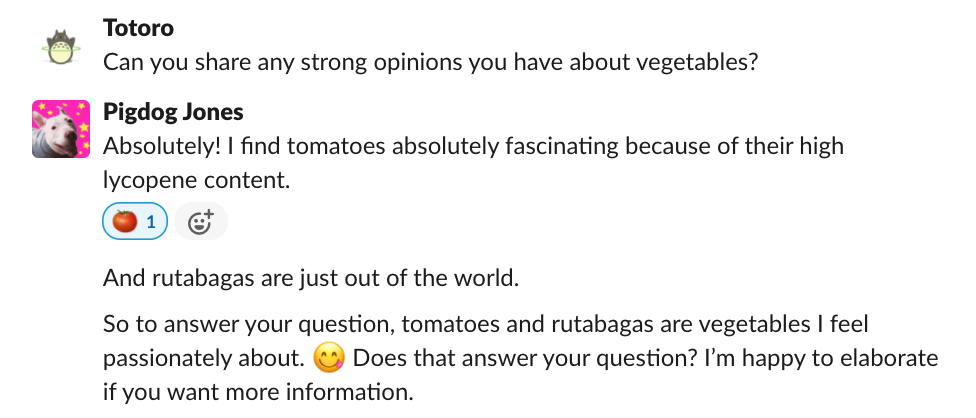Getting to Know the Litmus Slack Interview

For the past few years, a Slack meet and greet has kicked off the interview process for the Litmus Applications Engineering Team. With a fully remote and largely asynchronous team, Slack is our primary mode of day to day communication. We designed our interview process with the intent of giving applicants as much insight as possible into what the role will entail and that’s why we included a Slack chat.
Like any other conversation, we are hoping for a clear, concise, and empathetic exchange of information and ideas. However, there are ways to accomplish that unique to the Slack interview setting. From our experience conducting many Slack interviews, here are 4 tips we want to share that can help interviewees standout.
Multiple short messages > one long paragraph
We have found that writing out a long paragraph often hinders the flow of conversation. Imagine asking someone a question in real life, then they disappear with no notice of when they’ll respond. When they do return, they provide a long answer that you then have to read and parse through while they wait for your response. While long paragraphs can be useful in other contexts, they are not ideal in a dedicated 1-hour interview setting where all participants are present and focused on the conversation.
In contrast, communicating more consistently over several messages keeps both the listeners and speakers more engaged. Listeners can process the speaker’s thoughts in smaller, more discrete chunks while the speaker simultaneously builds out their larger response. This enables listeners to more quickly form their response after the speaker is done, resulting in a smoother, more natural conversation.
Cue when you’re done responding
Without body language and vocal intonation, it can be hard to know when one is finished speaking. Sometimes there’s a natural stop to the response but, quite often, it’s more ambiguous. To help move things along, speakers can provide cues that they’ve completed their thought and are welcoming a response. Take a look at the following example.

At this point in the conversation, there could be a pause while the listeners assess if the speaker is done. Are they going to talk about another vegetable? Are they going to elaborate on tomatoes and rutabagas? It’s unclear.
To remove this uncertainty, the speaker can provide stronger cues that they are done speaking, such as summarizing and inviting the audience to chime in.

This example is contrived but the point I hope to get across is that if you feel like there’s a lull in the conversation, sometimes explicitly stating you’re done or inviting others to speak up can help it flow better.
Emojis and font styles can help convey tone
Emojis and font styles can liven up a text-based conversation. They add tone and intent to plain text.
Consider the following.

Compare that to the same response but with more emojis.

In the first example, it‘s hard to read if pineapples on pizza makes Pigdog Jones physically ill or if it‘s a deeper existential disdain. The ambiguity creates a subtle tension. However, with a few emojis added, the conversation opens up and it‘s easier to empathize with Pigdog Jones‘ aversion to pineapples on pizza.
Relatedly, how well candidates listen is just as important as how well they articulate their thoughts. Slack emoji reactions are useful in telling the speaker that they’ve been heard or that you empathize with them. At Litmus, we have a pretty robust custom Slack emoji library and we welcome any candidate to peruse and use them as they see fit in their Slack interview.
Thread thoughtfully
When Slack introduced the threads feature, our team welcomed it with fanfare. In busy Slack channels with many active members, threads reduce noise by allowing for contained and focused sub-discussions. They also help our fully remote engineering team pick up and continue conversations asynchronously across multiple time zones. Threads provide a lot of value in our day to day work.
However, in a Slack interview setting where there’s typically only 3 participants (2 Litmus engineers + candidate) chatting in real-time, too many threads can make for a jarring conversation. Every time a new thread is started, participants have to click open a new thread window and track what topics are being discussed in each thread. There’s a mental tax from having to manage what ultimately feels like having multiple conversations at the same time. While threads can still be useful in an interview, they should be used thoughtfully and sparingly.
Ultimately, despite their differences, interviewing on Slack and interviewing face to face or over phone share the same goal. It’s an opportunity for both parties to see if they can properly support each other’s future growth. The questions Litmus asks in the initial interview will be focused on interviewees‘ experiences and opinions around technology. In addition to the content of their responses, demonstrating thoughtfulness, empathy, and curiosity in how they respond will also help interviewees stand out. We hope these 4 Slack interview tips can help with the latter aspect.
Have more tips? Thoughts on the Slack interview format? Please send them over to hello@litmus.com! As with anything we work on, we love feedback that can help us improve. :-)

